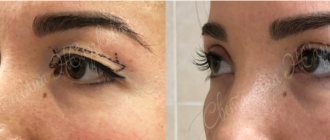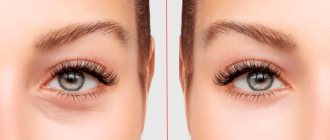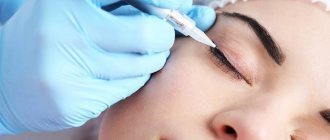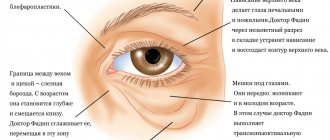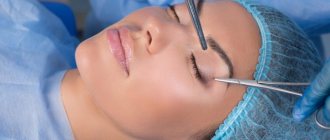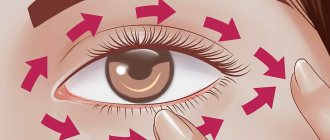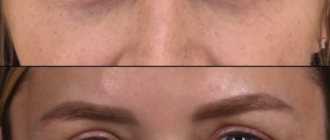Asian eyelid surgery is becoming increasingly popular in plastic surgery. The purpose of this operation is not always the Europeanization of the eyelids; many patients with an oriental face type have their own ideas about the beauty of the eyes and only want to slightly adjust the shape and cut, while maintaining the features of an Asian face. Another part of patients decide to undergo plastic surgery to eliminate age-related changes and rejuvenate the upper third of the face.
Types of operations
- Creation of European eyelids (oriental blepharoplasty):
formation of the eyelid fold, removal of the skin epicanthus, increasing the size and length of the eye shape. - Correction of the shape of Asian eyes, for example, highlighting the double eyelid, softening the epicanthus.
- Rejuvenation and lifting of the eyelids,
elimination of ptosis of the upper eyelid, removal of hernias and bags under the eyes.
Asian eye surgery - features of the procedure
This type of blepharoplasty allows you to change the shape of the patient's eyes. The doctor removes the overhanging tissue of the upper eyelid and forms a fold. As a result, the eyes “open” and visually enlarge, although, of course, in reality the size of the orbit and eyeball does not change. Asian eyelid surgery in Moscow is performed in two ways:
- With a cut. The procedure can significantly change the shape of the eyes. The surgeon makes incisions in the folds of the eyelid, so the stitches are not visible. The disadvantage of the method is a longer rehabilitation period.
- No cut. A more gentle, but less effective option. In this case, the doctor still makes incisions. They are simply located not on the skin, but on the surface of the mucous membrane. This method is used only if the tissues of the upper eyelid are quite thin.
Blepharoplasty is performed under both general and local anesthesia. It lasts about two hours. After the operation, the patient is given a bandage. You will have to stay in the hospital for several hours under the supervision of specialists.
The first results of the procedure are noticeable after 2 weeks. The surgeon will remove the sutures after 4–5 days for blepharoplasty without incisions and after 8–9 days for surgery with incisions. After this, you can apply makeup and use your usual cosmetics. The scars will completely disappear in a month.
Asian eyelids
Asian eyelid surgery is an operation aimed at correcting the structural features of oriental eyes. Manipulation is also often called "Singapuri". The correction is carried out in order to bring the eye shape closer to the European one. There are no medical indications for the operation - it is performed solely at the patient’s personal request and with the permission of the surgeon.
It is important! Asian eyes are not just narrow. They have a specific structure, which is noticeably different from the European one. But thanks to the development of plastic surgery, this feature can be corrected.
What is Asian eyelid surgery?
The procedure has gained popularity recently. Thanks to the operation, it is possible to create a so-called double European eyelid and eliminate the epicanthus. Thus, eastern eyes do not have a supraorbital fold, or fold of the upper eyelid, and the upper eyelid appears more voluminous than the lower. There is an overhanging fold of skin in the inner corner of the eye.
Indications for Asian eyelid surgery
- Too narrow eye shape.
- Absence of the supraorbital fold or its smoothness.
- Aesthetic necessity.
Plastic surgery allows you to eliminate overhanging tissue and form a fold in the upper eyelid, resulting in a more open and clear look. In the “before” and “after” photos you can see how your appearance changes as a result of such an operation!
The main types of Asian eyelid surgery
- With an incision - this is the gold standard in the correction of Asian eyes. The incisions are made in the natural folds of the eyelids, which allows you to carefully disguise the traces of surgery. No seams, scars or visible stripes! The only thing is that with this technology, recovery after surgery will take longer.
- Without an incision (special suture technology) – involves making incisions on the inside of the eyelid. It is done when the skin of the eyelids is thin and there is a small fold. Popular among young patients. Recovery after correction is relatively quick.
Preparing for plastic surgery
Preparing the patient for the upcoming surgical intervention is the same as for other eyelid surgeries. The person is examined by a surgeon, ophthalmologist, and specialized specialists. It is necessary to take a general and biochemical blood test, a urine test, a cardiogram, etc.
Stages of Asian eye surgery
- Stage No. 1 – during the “incision” operation, the eyelid is cut in two places. Excess tissue is excised from the upper eyelid, after which the edge of the skin of the lower incision is sutured to the aponeurosis of the muscle and the skin of the upper incision. A continuous suture is applied. With the suture method, a fold of the upper eyelid is formed, all layers between the muscle aponeurosis and the skin are sutured. Small punctures are made through which sutures are placed.
- Stage No. 2 – smoothing of the epicanthus. After some time, the area of the supraorbital fold is smoothed out.
- Stage No. 3 – removal of fatty hernias. Incisions are made through which the fatty tissue is removed. The manipulation is performed on both the upper and lower eyelids. The average duration of the operation is from 90 to 120 minutes, depending on the complexity. The operation is performed under local anesthesia, although in some cases general anesthesia may be necessary.
Rehabilitation
- After the operation, a bandage is applied to the eyes.
- Bruising and swelling will persist for 10-14 days.
- For suture surgery, the sutures are removed on days 3-5, and for blepharoplasty with incisions - for 7-8 days.
- After 3-4 weeks, postoperative scars noticeably lighten and become thinner.
- After just a couple of weeks, you can apply makeup to your eyes.
- The final effect can be assessed 2-4 months after surgery.
- The patient can return to a normal lifestyle 2 weeks after plastic surgery.
Immediately after surgery, surgeons recommend:
- use antibacterial drops and pain-relieving gels;
- apply sterile cold compresses to the eyelids;
- do not engage in active sports for 1-2 months;
- limit visits to the pool, sauna, bathhouse;
- Be sure to protect your eyes with sunglasses.
Asian eye surgery in Moscow - where is the best place to have it done?
There are many clinics offering this procedure. After all, plastic surgery for Asian eyes is quite in demand in Moscow. But remember: you shouldn’t risk your health and appearance and trust unverified clinics. Before you decide to go under the scalpel, read the reviews, find out about the experience of the doctors and the equipment of the medical center. You must be confident that blepharoplasty will be successful and without complications.
Dr. Listratenkova will tell you in detail about the operation, possible risks, contraindications, assess the condition of the skin and select the best option for blepharoplasty. The experience of our doctor, a serious approach to plastic surgery, and constantly updated equipment guarantee the safety of any operation.
Operation
Asian eyelid surgery is a technically very complex operation, which requires special care and precision on the part of the surgeon. Even minor errors can significantly distort the final result. As part of the surgical intervention, the following manipulations can be used:
- sangapuri
creation of the upper fold, correction of its shape and length. The essence of the procedure is to suture the skin to the muscle tendon. - epicanthoplasty
- plastic surgery of the skin located between the inner corner of the eye and nose. The technique is based on excision and/or removal of excess skin. - Removal of fatty hernias
is carried out through the mucous membrane. Manipulations involve the removal or redistribution of fatty tissue. - Correction of ptosis of the upper eyelid
is carried out by resection and tightening of the skin on the upper eyelid.
Operation process.
The surgical technique may vary depending on the individual characteristics of the eye structure, as well as the patient’s personal preferences. Preparation for eyelid surgery is no different from other surgical interventions: a medical examination, consultation with a therapist and an anesthesiologist at the clinic are required. All manipulations are performed under general anesthesia.
Transconjunctival blepharoplasty in “El. En."
Our clinic practices a special approach: for each patient individually and in accordance with her wishes, the surgeon draws up a surgical plan and determines the required types of correction.
The operation is performed under local anesthesia, the patient goes home on the day of the operation or the next day with an accompanying person. The sutures are removed on days 5-7, the patient is under the constant vigilant supervision of the surgeon (you can also call at night if something suddenly appears or bothers you). The results after the operation will last for many years - throughout your life. However, it should be understood that age-related changes cannot be avoided: sooner or later, wrinkles will begin to form in the paraorbital area. Skin loses elasticity. Age-related changes are eliminated using injection or hardware techniques, in “advanced” cases - by repeated surgical intervention, this time for the purpose of rejuvenation.
Still have questions? Call us!
Types of corrections performed during Asian blepharoplasty
Formation of folds on the upper eyelids.
In the absence of excess skin tissue, a fold can be formed without incisions: small punctures are made and then the tissue is stitched between the muscle aponeurosis and the skin. When it is necessary to eliminate excess skin hanging over the eyes and creating the impression of a heavy look, a classic correction is performed with an incision above the lash line.
Elimination of epicanthus.
The epicanthus (or Mongoloid fold) is the fold in the inner corner of the eye, behind which is the lacrimal tubercle. The epicanthus is eliminated by partial resection of the orbital muscle and excision of excess skin.
Elimination of fatty hernias.
Accumulations of fatty tissue form swellings, which create the impression of swelling in the paraorbital area. Swelling makes it painful and stale, and therefore many ladies prefer to get rid of it by removing fatty hernias. Hernias from the upper eyelids are “liquidated” along with the removal of excess skin and the formation of a double fold. As for the lower eyelids, closed access is possible here, when the hernia is removed through an incision made along the conjunctiva (as if “from inside” the eye).
Eye shape correction.
Some representatives of the Asian race also want to change the shape of their eyes, raise the outer drooping corners up, “stretch” their eyes a little to the sides, and change the shape of the eyes. All these problems are successfully solved during canthoplasty (together or separately with other corrections) or canthopexy, when the canthal muscle is affected.
Contraindications
- oncology;
- pregnancy and lactation;
- blood clotting disorder;
- cardiovascular diseases;
- general infections in the body;
- inflammatory processes in the intended intervention area;
- diabetes;
- chronic diseases in the acute stage;
- increased intraocular or blood pressure;
- thyroid diseases;
- dry eye syndrome
- blood diseases.
Memo for preparing for blepharoplasty: tests, prohibitions, recommendations
Preoperative examinations before blepharoplasty
Rehabilitation
You will spend the first day after the operation in the hospital of our clinic. Next, the attending physician will discharge you home, having previously drawn up a detailed plan for examination visits and a list of necessary medications and manipulations. Swelling and hematomas on the eyelids will resolve within a month to a month and a half after surgery. During this period, you need to avoid intense physical activity, tanning, and cosmetic procedures.
You will fully appreciate the result of the Europeanization of your look in 2-3 months.
To learn more about oriental blepharoplasty, schedule a consultation at our aesthetic medicine center.
Asian eyelid surgery: price
The price for oriental eye surgery is higher than for aesthetic blepharoplasty. This is due to the fact that this operation is somewhat more complicated and takes more time. The cost can be clarified during a free consultation at our Institute of Plastic Surgery and Cosmetology!
Attention! All aesthetic plastic surgeries and most cosmetic procedures are strictly contraindicated for pregnant and lactating women. We also do not perform surgical interventions on people whose weight exceeds 110 kg.
Blepharoplasty for Asian eyes
Singapura or Asian eye blepharoplasty is a plastic surgery aimed at surgically correcting a specific eye shape that people in Asia and the northern regions of Russia have from birth. Minor differences from European ones include the absence of a supraorbital fold, a swollen upper eyelid and the presence of an epicanthus. All this makes the look tired and expressionless, which does not suit many representatives of this race.
Blepharoplasty of Asian eyes at Level Clinic
In most cases, the operation is performed using minimally invasive technologies, which not only provides an excellent cosmetic effect, but also significantly reduces the recovery period. This is important for young, active people, as it allows them to go back to work within a few days after the correction and lead their usual lifestyle with minimal restrictions. In the photo after blepharoplasty of Asian eyes you can see the obvious effect of such an intervention. By choosing our clinic, you get a lot of advantages:
- The low-traumatic operation will not require a long hospital stay.
- Complete absence of scars or other traces of surgery on the face.
- After 2-3 days you can begin to perform your daily duties.
- The minimum number of restrictions in the postoperative period.
In what cases is surgery necessary?
Such a surgical intervention as blepharoplasty of Asian eyes has a minimum of medical indications - the majority of patients are guided only by aesthetic considerations. Eyelid correction performed by our experienced surgeons completely eliminates the natural features of Asian appearance, makes the eyes open, and eliminates traditional “heaviness.” Main indications for corrective measures:
- Drooping eyelids, giving the eyes a tired look.
- Unpronounced natural double fold on the upper eyelid.
- Loose skin in the subborbital area
- Bags, swelling, a large number of wrinkles.
- Narrow incision, as well as congenital defects.
Types of blepharoplasty for Asian eyes
To reshape the eyes, surgeons have to remove excess fatty tissue and reduce the epicanthus on the eyelids. In some cases, fatty tissue is removed not only from above, but also from below, which gives the look a European character. After agreeing on the details with the patient, the surgical technique is finally determined, and it can also be non-surgical (without incisions) or with a partial skin incision.
Suture plastic
This is a non-incision correction technique that can be used for mild ptosis that does not require major correction or thin skin. During suture blepharoplasty of Asian eyes, small punctures are made between the muscle aponeurosis and the skin, through which sutures are placed to lift the upper eyelid and form the fold characteristic of Europeans. No traces remain, but pronounced changes or defects cannot be eliminated with this technique.
Plastic surgery with full/partial incision
Thanks to this operation, serious changes can be eliminated and the look can be made as open as possible. Intervention with incisions allows you to remove excess skin and fatty tissue and change the contours. Such blepharoplasty of Asian eyes in the photo, as in life, looks completely invisible. This is achieved by the short length of the incisions, which subsequently become almost invisible. In the postoperative period there is practically no swelling. Cases of disappearance of the formed fold on the upper eyelid are minimal. This technology eliminates the epicanthus or “Mongolian fold” because partial excision of the orbicularis muscle becomes possible.
Before and after blepharoplasty for Asian eyes
Due to the use of minimally invasive techniques, general anesthesia is not required - the intervention is performed under local anesthesia. Preparation for correction is minimal. A week before surgery, you should stop taking medications that thin your blood, and avoid alcohol and smoking. A standard examination is prescribed - laboratory blood tests, ECG. Restrictions in the postoperative period are standard. You cannot: sunbathe, use cosmetics, visit swimming pools, saunas. Watching TV and working at the computer are limited; the doctor may prescribe special drops to prevent dryness. Physiotherapeutic procedures are recommended, which can also be performed in the clinic.

